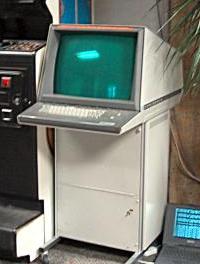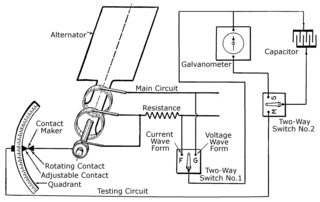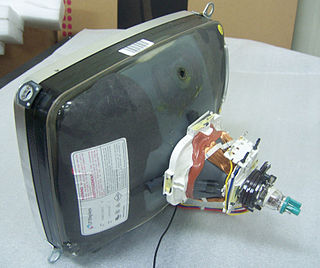Related Research Articles

A cathode-ray tube (CRT) is a vacuum tube containing one or more electron guns, which emit electron beams that are manipulated to display images on a phosphorescent screen. The images may represent electrical waveforms (oscilloscope), pictures, radar targets, or other phenomena. A CRT on a television set is commonly called a picture tube. CRTs have also been used as memory devices, in which case the screen is not intended to be visible to an observer. The term cathode ray was used to describe electron beams when they were first discovered, before it was understood that what was emitted from the cathode was a beam of electrons.

Trinitron was Sony's brand name for its line of aperture-grille-based CRTs used in television sets and computer monitors. One of the first television systems to enter the market since the 1950s. Constant improvement in the basic technology and attention to overall quality allowed Sony to charge a premium for Trinitron devices into the 1990s.

The Selectron was an early form of digital computer memory developed by Jan A. Rajchman and his group at the Radio Corporation of America (RCA) under the direction of Vladimir K. Zworykin. It was a vacuum tube that stored digital data as electrostatic charges using technology similar to the Williams tube storage device. The team was never able to produce a commercially viable form of Selectron before magnetic-core memory became almost universal.

A flat-panel display (FPD) is an electronic display used to display visual content such as text or images. It is present in consumer, medical, transportation, and industrial equipment.

Video camera tubes were devices based on the cathode ray tube that were used in television cameras to capture television images, prior to the introduction of charge-coupled device (CCD) image sensors in the 1980s. Several different types of tubes were in use from the early 1930s, and as late as the 1990s.

Storage tubes are a class of cathode-ray tubes (CRTs) that are designed to hold an image for a long period of time, typically as long as power is supplied to the tube.

A surface-conduction electron-emitter display (SED) is a display technology for flat panel displays developed by a number of companies. SEDs use nanoscopic-scale electron emitters to energize colored phosphors and produce an image. In a general sense, a SED consists of a matrix of tiny cathode-ray tubes, each "tube" forming a single sub-pixel on the screen, grouped in threes to form red-green-blue (RGB) pixels. SEDs combine the advantages of CRTs, namely their high contrast ratios, wide viewing angles, and very fast response times, with the packaging advantages of LCD and other flat panel displays. They also use much less power than an LCD television of the same size.

A raster scan, or raster scanning, is the rectangular pattern of image capture and reconstruction in television. By analogy, the term is used for raster graphics, the pattern of image storage and transmission used in most computer bitmap image systems. The word raster comes from the Latin word rastrum, which is derived from radere ; see also rastrum, an instrument for drawing musical staff lines. The pattern left by the lines of a rake, when drawn straight, resembles the parallel lines of a raster: this line-by-line scanning is what creates a raster. It is a systematic process of covering the area progressively, one line at a time. Although often a great deal faster, it is similar in the most general sense to how one's gaze travels when one reads lines of text.

Large-screen television technology developed rapidly in the late 1990s and 2000s. Prior to the development of thin-screen technologies, rear-projection television was standard for larger displays, and jumbotron, a non-projection video display technology, was used at stadiums and concerts. Various thin-screen technologies are being developed, but only liquid crystal display (LCD), plasma display (PDP) and Digital Light Processing (DLP) have been publicly released. Recent technologies like organic light-emitting diode (OLED) as well as not-yet-released technologies like surface-conduction electron-emitter display (SED) or field emission display (FED) are in development to replace earlier flat-screen technologies in picture quality.

Rear-projection television (RPTV) is a type of large-screen television display technology. Until approximately 2006, most of the relatively affordable consumer large screen TVs up to 100 in (250 cm) used rear-projection technology. A variation is a video projector, using similar technology, which projects onto a screen.
The Chromatron is a color television cathode ray tube design invented by Nobel prize-winner Ernest Lawrence and developed commercially by Paramount Pictures, Sony, Litton Industries and others. The Chromatron offered brighter images than conventional color television systems using a shadow mask, but a host of development problems kept it from being widely used in spite of years of development. Sony eventually abandoned it in favor of their famous Trinitron system using an aperture grille.
The Geer tube was an early single-tube color television cathode ray tube, developed by Willard Geer. The Geer tube used a pattern of small phosphor-covered three-sided pyramids on the inside of the CRT faceplate to mix separate red, green and blue signals from three electron guns. The Geer tube had a number of disadvantages, and was never used commercially due to the much better images generated by RCA's shadow mask system. Nevertheless, Geer's patent was awarded first, and RCA purchased an option on it in case their own developments didn't pan out.
The beam-index tube is a color television cathode ray tube (CRT) design, using phosphor stripes and active-feedback timing, rather than phosphor dots and a beam-shadowing mask as developed by RCA. Beam indexing offered much brighter pictures than shadow-mask CRTs, reducing power consumption, and as they used a single electron gun rather than three, they were easier to build and required no alignment adjustments.
Electrically operated display devices have developed from electromechanical systems for display of text, up to all-electronic devices capable of full-motion 3D color graphic displays. Electromagnetic devices, using a solenoid coil to control a visible flag or flap, were the earliest type, and were used for text displays such as stock market prices and arrival/departure display times. The cathode ray tube was the workhorse of text and video display technology for several decades until being displaced by plasma, liquid crystal (LCD), and solid-state devices such as thin-film transistors (TFTs), LEDs and OLEDs. With the advent of metal–oxide–semiconductor field-effect transistors (MOSFETs), integrated circuit (IC) chips, microprocessors, and microelectronic devices, many more individual picture elements ("pixels") could be incorporated into one display device, allowing graphic displays and video.
This is a subdivision of the Oscilloscope article, discussing the various types and models of oscilloscopes in greater detail.

The history of the oscilloscope was fundamental to science because an oscilloscope is a device for viewing waveform oscillations, as of electrical voltage or current, in order to measure frequency and other wave characteristics. This was important in developing electromagnetic theory. The first recordings of waveforms were with a galvanometer coupled to a mechanical drawing system dating from the second decade of the 19th century. The modern day digital oscilloscope is a consequence of multiple generations of development of the oscillograph, cathode-ray tubes, analog oscilloscopes, and digital electronics.

The cathode-ray tube amusement device is the earliest known interactive electronic game as well as the first game to incorporate an electronic display. The device simulates an artillery shell arcing towards targets on a cathode-ray tube (CRT) screen, which is controlled by the player by adjusting knobs to change the trajectory of a CRT beam spot on the display in order to reach plastic targets overlaid on the screen. Thomas T. Goldsmith Jr. and Estle Ray Mann constructed the game from analog electronics and filed for a patent in 1947, which was issued the following year. The gaming device was never manufactured or marketed to the public, so it had no effect on the future video game industry. Under many definitions, the device is not considered a video game, as while it had an electronic display it did not run on a computing device. Therefore, despite its relevance to the early history of video games, it is not generally considered a candidate for the title of the first video game.

Beam deflection tubes, sometimes known as sheet beam tubes, are vacuum tubes with an electron gun, a beam intensity control grid, a screen grid, sometimes a suppressor grid, and two electrostatic deflection electrodes on opposite sides of the electron beam that can direct the rectangular beam to either of two anodes in the same plane.
A time base generator is a special type of function generator, an electronic circuit that generates a varying voltage to produce a particular waveform. Time base generators produce very high frequency sawtooth waves specifically designed to deflect the beam of a cathode ray tube (CRT) smoothly across the face of the tube and then return it to its starting position.

A deflection yoke is a kind of magnetic lens, used in cathode ray tubes to scan the electron beam both vertically and horizontally over the whole screen.
References
Notes
Bibliography
- William Ross Aiken, "History of the Kaiser-Aiken, thin cathode ray tube", IEEE Transactions on Electron Devices, Volume 31 Issue 11 (November 1984), pp. 1605–1608
- A.W. Woodhead, "Flat cathode ray tubes", Physics in Technology, Volume 15 Issue 2 (March 1984), pp. 86–91
- Jaimeson Cobleigh, "Interview with William Ross Aiken", IEEE History Center, Interview #322, 30 October 1996
Patents
- U.S. Patent 2,795,731, "Cathode Ray Tube", William Ross Aiken/Kaiser Aircraft & Electronics, filed 4 December 1953, issued 11 June 1957
- "Description 179,404", "Television Receiver", William Ross Aiken/Kaiser Aircraft & Electronics, filed 21 January 1955, issued 18 December 1956
- U.S. Patent 2,837,691, "Electronic Device", William Ross Aiken/Kaiser Aircraft & Electronics, filed 24 August 1955, issued 2 June 1958
- U.S. Patent 2,879,443, "Electronic Device", William Ross Aiken/Kaiser Aircraft & Electronics, filed 15 December 1955, issued 24 March 1959
Further reading
- "Thin Tube Foretells Wall TV and Sky View for Air Pilot", Popular Mechanics, January 1958, pg. 104